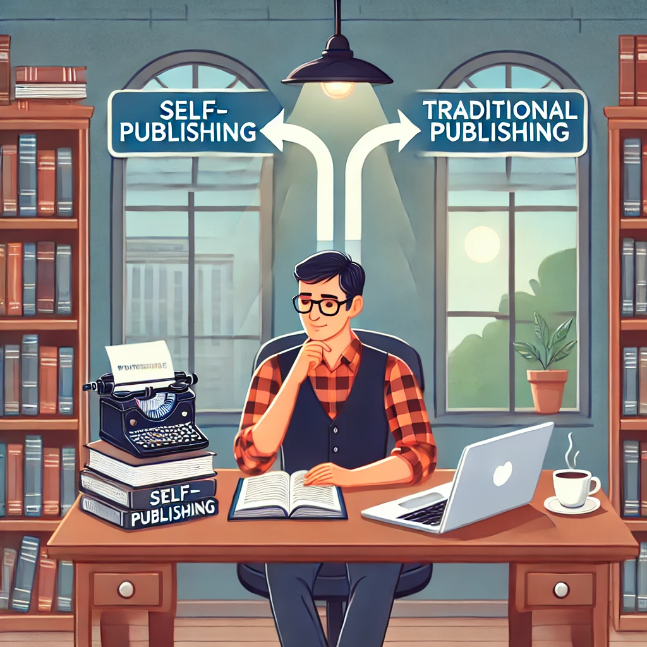Self-Publishing vs. Traditional Publishing: Which Path is Right for You?

In the evolving landscape of the publishing industry, authors have more choices than ever when it comes to getting their work into the hands of readers. The decision between self-publishing and traditional publishing can be daunting, each offering unique advantages and challenges. This article will explore the key differences between self-publishing and traditional publishing to help you decide which path is right for you.
1. Control and Creative Freedom
Self-Publishing: Self-publishing gives authors complete control over the entire publishing process. You get to make all the decisions, from the book cover design to the marketing strategy. This creative freedom allows you to bring your vision to life without any external interference.
Traditional Publishing: In traditional publishing, the publisher has the final say on many aspects of your book, including the cover design, title, and marketing approach. While this means you may have less creative control, you benefit from the expertise and resources of experienced professionals.
2. Time to Market
Self-Publishing: Self-publishing typically offers a much faster route to market. Once your manuscript is ready, you can publish your book within days or weeks. This speed can be particularly advantageous if you want to capitalize on current trends or get your work out quickly.
Traditional Publishing: The traditional publishing process can be lengthy. It often takes months, if not years, from the time you submit your manuscript to when your book is published. The process includes finding an agent, getting a publishing deal, and going through multiple rounds of editing and marketing planning.
3. Financial Considerations
Self-Publishing: Self-publishing requires an upfront investment for services such as editing, cover design, and marketing. However, you earn a higher percentage of royalties per sale, often between 70-85%. This can be financially rewarding if your book sells well.
Traditional Publishing: Traditional publishers cover the costs of editing, design, and marketing. In return, they take a significant portion of the royalties, typically leaving the author with 10-15% per sale. However, you may receive an advance payment, which provides some financial security upfront.
4. Distribution and Reach
Self-Publishing: Self-published books are primarily sold online, through platforms like Amazon Kindle Direct Publishing (KDP), Apple Books, and Kobo. While this can provide global reach, getting your book into brick-and-mortar bookstores can be challenging.
Traditional Publishing: Traditional publishers have established distribution networks, making it easier to get your book into bookstores, libraries, and other physical outlets. This can significantly enhance your book's visibility and sales potential.
5. Marketing and Promotion
Self-Publishing: As a self-published author, you are responsible for all marketing and promotion efforts. This requires a significant time investment and marketing knowledge. However, you have the flexibility to implement creative and personalized marketing strategies.
Traditional Publishing: Traditional publishers provide marketing and promotional support, including book tours, media coverage, and advertising campaigns. While this can significantly boost your book's visibility, the level of marketing support can vary depending on the publisher and the book's perceived market potential.
Tips for Making Your Decision
- Assess Your Goals: Consider what you want to achieve with your book. Are you looking for creative control, a quick release, or extensive distribution?
- Evaluate Your Resources: Determine your budget for publishing-related expenses and your ability to handle marketing and promotion efforts.
- Research the Market: Understand the current market trends and the performance of books in your genre. This can help you decide which publishing route aligns with your goals.
- Consider Hybrid Publishing: Hybrid publishing combines elements of both self-publishing and traditional publishing, offering a middle ground. This can be a viable option if you want some level of support while retaining more control and higher royalties.
Conclusion
Both self-publishing and traditional publishing offer unique benefits and challenges. The right choice depends on your individual goals, resources, and preferences. By carefully considering these factors, you can choose the publishing path that best aligns with your vision and objectives. Remember, whichever route you choose, the most important thing is to stay committed to your writing journey and continue creating great content for your readers.
To learn more about the intricacies of publishing, check out our detailed guides on Top Book Cover Sharing Websites That Allow Authors to Submit Their Book Covers for Contests and The Importance of Book Reviews in Building Author Credibility and Boosting Sales.



